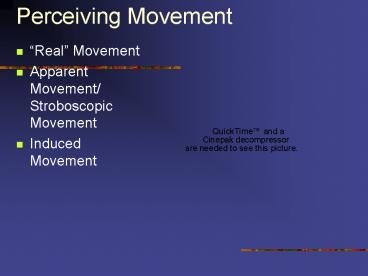Perceiving Movement - PowerPoint PPT Presentation
1 / 19
Title:
Perceiving Movement
Description:
Relative motion produces the illusion of movement in the stationary object. ... 1) Foreground object moves against a stationary background; ... – PowerPoint PPT presentation
Number of Views:149
Avg rating:3.0/5.0
Title: Perceiving Movement
1
Perceiving Movement
- Real Movement
- Apparent Movement/StroboscopicMovement
- Induced Movement
2
Perceiving Movement
- Apparent Movement/Stroboscopic Movement
3
Perceiving Movement
- Induced MovementImagine sitting in a train and
the there is a train next to yours. When the
other train moves, at first it might feel that
your train is moving backwards. - Relative motion produces the illusion of movement
in the stationary object. This is referred to as
vection.
4
Perceiving Movement
- Movement Afterimage
5
Perceiving Movement
- Neural Feature DetectorsBars at different
angles were shown to cats. Some cells responded
selectively to the orientation of the bars
6
Perceiving Movement
- Neural Feature DetectorsThis network responds
to movement from right to left but not left to
right
7
Perceiving Movement
- Neural Feature Detectors
8
Perceiving Movement
- Neural Feature Detectors
9
Perceiving Movement
- Neural Feature DetectorsWhen monkeys were
trained to detect movement, neurons in the Medial
Temporal Dorsal stream fired at a higher rate
when the dot movement was correlated
10
Perceiving Movement
- Corollary Discharge Theory Motor Signals (MS)
to move the eyes, including a Corollary Discharge
Signal (CDS) and and Image Movement Signal (IMS)
are processed by the Comparator. The IMS and the
MS balance each other out.
11
Perceiving Movement
- Corollary Discharge Theory Motor Signals (MS)
to move the eyes, including a Corollary Discharge
Signal (CDS) and an Image Movement Signal (IMS)
are processed by a Comparator - Perception of movement w/o movement in the retina
1. Move eyes while viewing an afterimage in the
dark. You have a MS and CDS but no IMS.
Afterimage moves with the retina2. Push on your
eyeball while looking at a stationary location.
You get CDS w/o IMS. Scene moves.3. Follow a
moving object with eyes. You get CDS w/o IMS.
Object appears to be moving.4. Paralyze your eye
muscles and then try to move your eyes. You
get CDS w/o IMS. The scene moves.
12
Perceiving Movement
- Corollary Discharge Theory This study of
monkeys showed that certain neurons only respond
to the IMS and take eye movement into account.
13
Perceiving Movement
- The Optic Array
- 1) Foreground object moves against a stationary
background - 2) The entire scene moves, indicating the
observer is moving
14
Perceptual Organization andMovement
15
Perceptual Organization Movement
- Biological Motion
16
Perceptual Organization Movement
- Biological Motion
17
Perceptual Organization Movement
- Structure from motion the kinetic depth effect
18
Perceptual Organization Movement
- Motion capture items forming groups move together
19
Perceptual Organization Movement
- Constraints on movement































